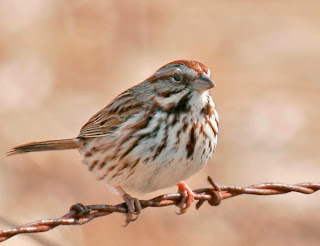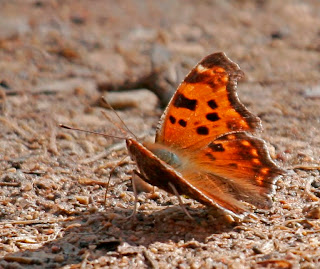After an unseasonably warm week, March temperatures are back (30-degrees cooler). But we haven't had any precipitation all month. In fact, if the dry weather continues, this could set a record for the driest March ever.
It was chilly, but the sun was shining.
Saturday is our day to shop in Eau Claire, and on the way, take a spin through one of the most species-diverse locations in Wisconsin - the little dot on the map along the Lower Chippewa River known as Meridean (no, they didn't mis-spell me-rid-i-an, it's pronounced
merry-dean).
We didn't get very far on State Road 25 before I spotted another early migrant, our first-of-the-year Killdeers.
A pair of them was foraging along the road, next to a recently plowed potato field. I cringe when I think of all the chemical-laden food these birds eat.
It won't be long before these fields will be marked with little red
"peligro - poison" signs when they start laying down this year's pesticide layers. A neighbor explained the reason for the signs, and said: I only eat organic vegetables. I think about that conversation every time I drive by.
I continued north on State Rd 25 and turned on to County M. Because of the change in temperature, I had to drive with the windows up and the seat heater "on." Heated seats were not on my "gotta have it" list when I was shopping for a new car. But that and the leather seats came with only Prius left on the lot. My choice was buy it or miss-out on the "cash for clunkers" rebate.
I want to believe that I bought a safe car, and all the to-do about the run-away Priuses and Toyota "quality control issues" will dissipate with time. I still worry about my "investment," but for the most part, I really like my Prius. Every time I drive to Eau Claire, I get ~60 MPGs. Amazing.
But unlike our outings earlier this week, we didn't spot any insects, and only a couple of squirrels, crows and bald eagles along the flooded river bottoms.
When we pulled in to Meridean, I spotted a small flock of Black-capped Chickadees flitting from tree to tree. I stopped and pulled out my iPod. I tuned it in to the Chickadee song on Bird Jam and turned up the volume on the car radio. It was as if my big black Prius had been transformed into a giant chickadee - and the little flock united in an effort to drive us away.
I snapped a few photos, then let them go back to looking for food.
We took in a movie - the new Jude Law flick -
Repo Men. To say it is violent - is an understatement. Interesting premise. The twist at the end caught both of us off guard. Rent it.
We picked up groceries then headed back through Meridean around 5:30. Along the way, we spotted two pairs of Canada Geese establishing territories at opposite sides of our favorite oxbow, a pair of mallards and our first Wood Ducks of the year.
Our biggest surprise came further down the road. We stopped to look at Eastern Bluebirds - and a Barred Owl flew right in front of the car, landing in a nearby tree!
"Who-cooks-for-you? Who-Cooks-for-you-all?"


















































